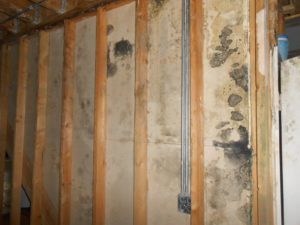 We all know that mold is sneaky. (Remember? Like a ninja.)
We all know that mold is sneaky. (Remember? Like a ninja.)
What do we do if it’s hiding in our walls, though?
Unfortunately it’s a common place for mold to grow and usually the last thing anyone wants to do is tear their walls down to resolve the issue.
Thankfully, you don’t have to!
What Tools Do We Need for Mold Removal?
There are quite a few tools used by experts that help us figure out whether or not you have a mold infestation within your walls. None of them include taking a sledgehammer to your walls.
Thermal Imaging Camera
One of the main tools we use in the mold inspection process is a thermal imaging camera. It has the ability to scan the room where mold is suspected and uses thermal energy to identify possible areas where mold colonies could be growing within your walls.
Any moisture within your walls has a different temperature than the rest of the area. That moisture combined with high humidity are two of mold’s favorite things so if we identify those two factors, there’s a good chance you might have mold.
Moisture Meter
This brings us to our next tool—the moisture meter. This is another common tool used for mold inspection as it can show us materials in the residence or commercial facility that have high enough moisture content to grow and feed mold colonies.
Borescope
A borescope is another camera. This camera, however, is much smaller and can give us views of areas that might not be accessible to the naked eye. It’s small enough to help identify any cracks or small nooks and crannies that you might miss otherwise. This helps us with more visual inspection and helps you not have your walls torn down.
Of course there are a couple of other signs there might be mold in your walls that don’t need any special tools.
Signs of Mold Growth in Your Walls
Even if you know nothing about mold, there are a few simple signs you can look for if you’re worried there might be mold lurking in your walls.
One of the biggies to look for is moisture.
Do you live in a particularly rainy area? Or maybe you’ve had a particularly rainy season? Is your basement waterproofed? These are all great points to start thinking about.
Does any area of your house have a musty smell? Mold smells musty and if you notice that odor in your house, it might be time for a closer inspection.
Even if you’ve noticed a small patch of mold and removed it yourself (you can with baking soda and vinegar), keep your nose out to see if that musty smell disappears. If not, the mold might be within your walls and not visible.
Where Do You Go From Here?
Finding mold in your house can be scary and overwhelming all at the same time if you don’t know the proper steps to take. It’s ok; we can help. If you’re unsure of what to do next, give us a call. We have an entire team of professionals ready to answer any questions you might have!







